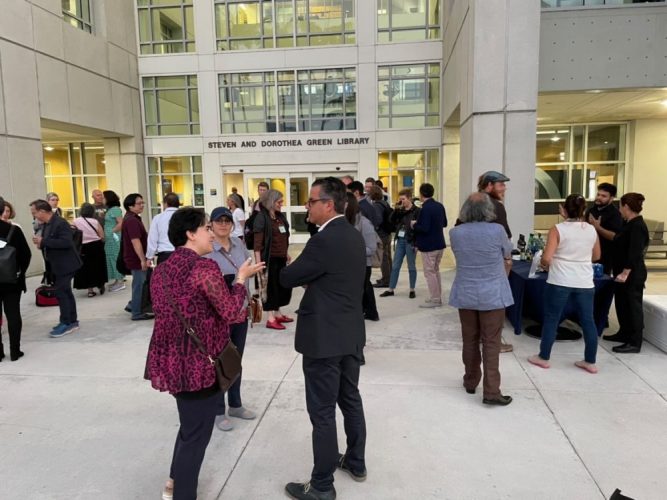Environmental, climate, social, financial, and technological changes are among the catalysts that raise the question: How will our cities and landscapes adapt and thrive?
This past Spring semester, the FIU School of Architecture hosted the 2022 Architectural Research Centers Consortium (ARCC) and the European Association for Architectural Education (EAAE) International Research Conference in Miami – Resilient City: Physical, Social & Economic Perspectives. Attendees spent their time discussing the effects of climate change and how can cities be more resilient.
Co-chaired by Associate Dean of Faculty + Program Development and distinguished university professor Marilys Nepomechie, and Director of Research and Technology and the Robotics and Digital Fabrication Lab, professor Shahin Vassigh, this year’s conference saw participation from more than 300 architecture and design professionals from 29 countries. The discussion focused on urban resilience: The challenges and opportunities for creating cities and landscapes resilient to social and environmental change.
“Through the lenses offered by the conference participants — the scholars, researchers, educators, paper presenters who came to share their exceptional work– we looked together at many aspects of resilience,” said Nepomechie. “Municipal government’s ongoing work to address urban scale challenges in a complex reality of compelling, and often competing interests. We are grateful for this opportunity to celebrate the value of being together by sharing our School of Architecture and our extraordinary city.”
Through these dialogues, the conference addressed the multiplicity of ways in which design pedagogies, research, and innovation, carried out across disciplines and professions, empower us to educate a new generation of built environment designers while meeting the strategic imperatives of this historical moment.
In addition to great international keynote lectures and exhibitions that were open to the public, both in-person and via Zoom, professors from around the world gathered at the School of Architecture to give paper and poster presentations and facilitate unique networking opportunities.
Keynotes featured a diverse line-up of speakers including James Murley (Chief Resilience Officer for Miami-Dade County); Jeremy Till (head of Central Saint Martins and pro-vice chancellor of the University of the Arts); Toni Griffin (professor in practice of Urban Planning at Harvard University and founder of urbanAC); Philippe Block (professor at the Institute of Technology in Architecture at ETH Zurich, where he co-directs the Block Research Group) and finally architect and landscape architect Susannah Drake (principal and founder of DLANDstudio).
“Our keynotes were truly inspirational, each addressing the conference theme of ‘resilience’ from a different perspective,” said Dr. Vassigh.
She described Jeremy Till’s talk as tone-setting for the conference, while, coming from a technological side, Philippe Block offered an “exciting idea” about how new robotic construction processes.
“These keynotes successfully anchored the papers sessions of the conference in the border context,” said professor Vassigh.
Climates of Inequality: Stories of Environmental Justice was housed in the Steven and Dorathea Green Library, however it can now be seen online at https://climatesofinequality.org/. The memory project is a collaboration among students, educators, and community leaders to activate communities that have contributed the least to climate change but may experience the most consequences. As a traveling exhibit with local events at every stop, the project seeks to elevate and affirm the work of such communities, while inspiring others to do the same. The exhibition is supported by the Wolfsonian Public Humanities Lab as part of the Commons for Justice Project funded by a grant from the Andrew J Mellon Foundation.
“The wisdom of communities at the front lines of environmental degradation is crucial to addressing the wellbeing of our ecosystems and ourselves,” said Gray Read, curator of the exhibition. “Architecture students from FIU used their drawing skill to tell stories visually in maps and images based on the memory of local agriculture workers who had left their homes in Central America and Mexico to escape a severe drought exacerbated by climate change.”
In addition, the conference included the exhibition Socio-Spatial Approaches for Resilient Cities, which highlights selected research projects that utilize advanced data-driven methodologies, participatory and community-centered practices, as well as digital fabrication and robotics for addressing the immediate and imminent climate change challenges of the built environment. The exhibit was curated by School of Architecture assistant professor, Biayna Bogosian.
“This conference offered a unique opportunity to couple theory and practice-based presentations on Resilient City with practical workshops,” said Bogosian. “They were on a range of topics including, NSF grant writing skills and publication contracts.”
Discussing the conference and exhibition topics at length and sharing an experience in person helped make this event engaging, provocative, and enriching for its attendees.



